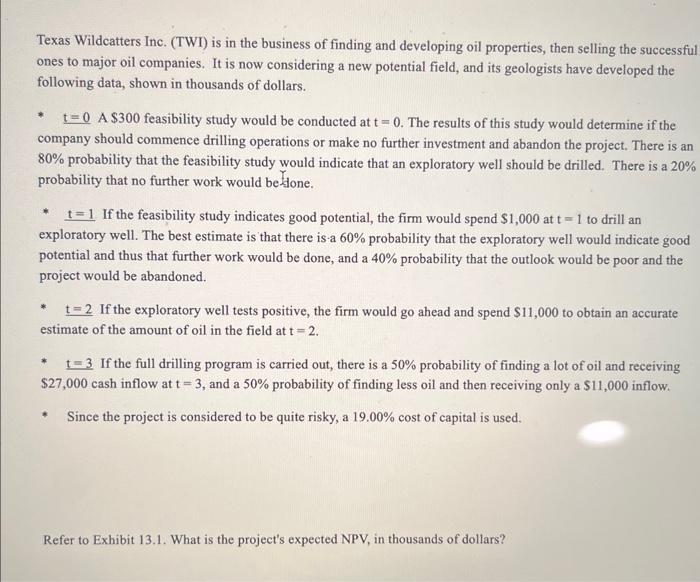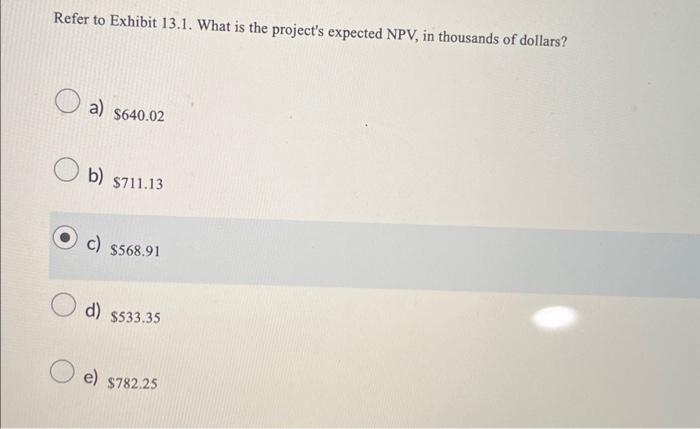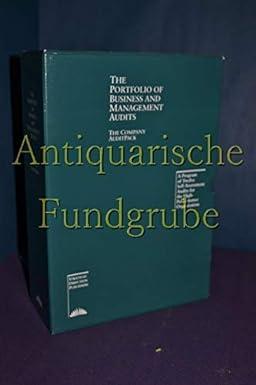Texas Wildcatters Inc. (TWI) is in the business of finding and developing oil properties, then selling the successful ones to major oil companies. It is now considering a new potential field, and its geologists have developed the following data, shown in thousands of dollars. * t=0 A $300 feasibility study would be conducted at t=0. The results of this study would determine if the company should commence drilling operations or make no further investment and abandon the project. There is an 80% probability that the feasibility study would indicate that an exploratory well should be drilled. There is a 20% probability that no further work would be Sone. t=1 If the feasibility study indicates good potential, the firm would spend $1,000 at t=1 to drill an exploratory well. The best estimate is that there is a 60% probability that the exploratory well would indicate good potential and thus that further work would be done, and a 40% probability that the outlook would be poor and the project would be abandoned. * t=2 If the exploratory well tests positive, the firm would go ahead and spend $11,000 to obtain an accurate estimate of the amount of oil in the field at t=2. * t=3 If the full drilling program is carried out, there is a 50% probability of finding a lot of oil and receiving $27,000 cash inflow at t=3, and a 50% probability of finding less oil and then receiving only a $11,000 inflow. * Since the project is considered to be quite risky, a 19.00% cost of capital is used. Refer to Exhibit 13.1. What is the project's expected NPV, in thousands of dollars? Refer to Exhibit 13.1. What is the project's expected NPV, in thousands of dollars? a) $640.02 b) $711.13 C) $568.91 d) $533.35 e) $782.25 Texas Wildcatters Inc. (TWI) is in the business of finding and developing oil properties, then selling the successful ones to major oil companies. It is now considering a new potential field, and its geologists have developed the following data, shown in thousands of dollars. * t=0 A $300 feasibility study would be conducted at t=0. The results of this study would determine if the company should commence drilling operations or make no further investment and abandon the project. There is an 80% probability that the feasibility study would indicate that an exploratory well should be drilled. There is a 20% probability that no further work would be Sone. t=1 If the feasibility study indicates good potential, the firm would spend $1,000 at t=1 to drill an exploratory well. The best estimate is that there is a 60% probability that the exploratory well would indicate good potential and thus that further work would be done, and a 40% probability that the outlook would be poor and the project would be abandoned. * t=2 If the exploratory well tests positive, the firm would go ahead and spend $11,000 to obtain an accurate estimate of the amount of oil in the field at t=2. * t=3 If the full drilling program is carried out, there is a 50% probability of finding a lot of oil and receiving $27,000 cash inflow at t=3, and a 50% probability of finding less oil and then receiving only a $11,000 inflow. * Since the project is considered to be quite risky, a 19.00% cost of capital is used. Refer to Exhibit 13.1. What is the project's expected NPV, in thousands of dollars? Refer to Exhibit 13.1. What is the project's expected NPV, in thousands of dollars? a) $640.02 b) $711.13 C) $568.91 d) $533.35 e) $782.25








